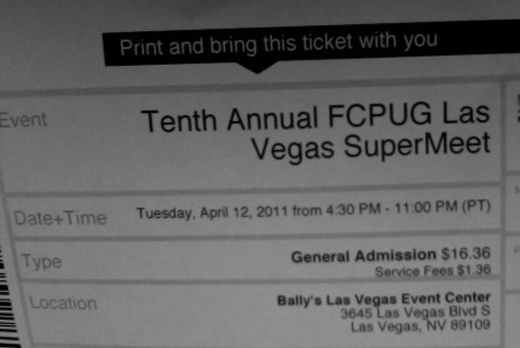Lots of excitement and drama in the Digital Video world as rumors are flying that Apple has taken over a meeting of Final Cut Pro users held tomorrow during the National Association of Broadcasters convention. According to most, Apple will use the opportunity to unveil a radical new vision of their non-linear video editor.
2011 will be 12 years since I first attended NAB, and I thought I’d go through my photo archives to see what I had from visiting Apple’s booth on the show floor over the years. Although Apple stopped having a large floor presence at the convention in 2008 (and won’t have one in 2011, no matter what they announce tomorrow), they’ve still been a major player in a multi-way tug-of-war between Adobe, Avid, Discreet and others through the years. We’ll start in…
1992
…when MacWeek Magazine covered the show in its April 20th issue:
Apple […] had a booth at the show; the company is aiming at the estimated 300,000 U.S. Video-production professionals, according to Kirk Shorte, Apple marketing manager for integrated media. “If Apple can win over the top video professionals to the Mac, there’s a multiplier effect of millions of people who produce scripts, budgets, animations and graphic images for video. Then there’s a trickle-down effect to an even bigger market of corporate video users and consumers who want to make home movies on their VCRs,” Shorte said.
1993
MacWeek looked forward to the 1993 show with an article in their April 19th issue “Mac video editing goes on-line at NAB show.” (Note here the early-1990s use of the term ‘on-line’ — it refers to spinning disks of digital data, not to the Internet.) The article mentions two vendors, one familiar to me and one not: ImMIX and Avid. The former’s product was based, perhaps inauspiciously, around a Mac IIvx — the pre-Quadra 030 Mac that rapidly became obsolete after the launch of Motorola’s 68040 chip. On the other hand, since much of the video processing in the ImMIX “Video Cube” was based on an outboard wavelet compression engine, the speed of the Mac host system may have been less crucial. Here’s what the setup looked like in action:

(May I just add — I don’t think I’ve ever seen a more incredible mash-up of ergonomic misconceptions and early-90s tech photography studio setups as the publicity shot above. What really seals the deal are the (13”!) monitors absurdly far away from the user. And yet this photoshoot wouldn’t look out of place on the cover of MacWorld, paint-splattered faux-granite columns and all.)
The ImMIX Video Cube seems to have been an evolutionary cul-de-sac based around wavelet codecs, a briefly-promising compression technique that lost ground to conventional JPEG approaches over time. But there was a moment where it looked like that approach would take over. In 1993, the ImMIX setup went for about $50-$60,000.
More recognizable to day is Avid, who were planning to show an “on-line” vision of their Media Composer software. (Again, this means a shift from tape-based to spinning disk media, nothing to do with networked connectivity.) $90k bought you a system that used dedicated C-Cube JPEG hardware to perform the compression and decompression of the video frame in real-time. It would be a long time before CPUs themselves could perform this task on their own.
Reporting the next week, after NAB had concluded, the same journalist wrote of how the Mac platform was positioning itself to “take on SGI” through partnerships with Avid and Alias. Apparently there was a press conference (or at the very least, a release) saying Avid would license and port tech from Lucasfilm’s EditDroid and SoundDroid turnkey systems, for incorporation into Avid’s Mac turnkey systems. And Alias (later Alias|Wavefront) announced translation software to help move files back and forth between Silicon Graphics systems and the Mac.
But my favorite part of this April 26th article is this:
Despite the latest technological inroads, however, many video professionals said they still have doubts about the video-processing capabilities of current Macs. Even Apple CEO John Sculley admitted in an NAB press conference that the processing power required for serious video production won’t be available on the Mac platform until the company’s RISC-based PowerPC Macs ship next year.
To be fair, Sculley was trying to create excitement around his company’s big, audacious bet to partner with IBM and Motorola around an entirely new processor architecture. He couldn’t have known that — although the raw speed of the 601 would indeed amaze — Apple’s inability to fully modernize and update their operating system would leave video editors with an emulated, non-“native” file system that for many years would hamstring high-throughput applications such as video editing.
I’m still working on getting print back issues of MacWeek from other years in the 1990s, so we’ll skip forward to…
1999
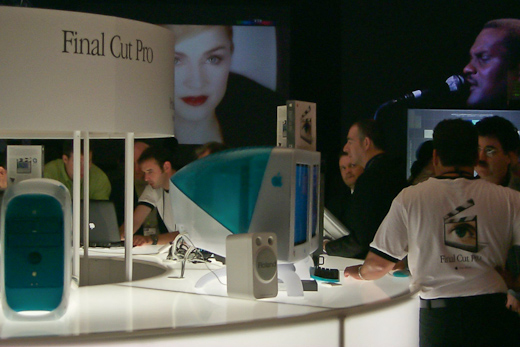
The first year after Apple has acquired video editing software called “Final Cut” from Macromedia. This NAB saw a large Apple booth on the show floor, with many blue-and-white G3’s demonstrating the newly-renamed Final Cut Pro. Note the dual CRT monitors in use here: flat-panels were still a way off as affordable, color-accurate output devices. DV and Firewire/1394 was everywhere — as the core of FCP, it was a new standard that everyone was trying to figure out.
2000
I was in New York, but PowerBooks made their debut as “Portable Movie Studios” featuring FireWire for connection to DV cameras. Blue-and-white G3s have turned into the first generation of silver G4s, and Cinema Displays have displaced CRTs. An Italian-language site has three good pictures online, including this one:
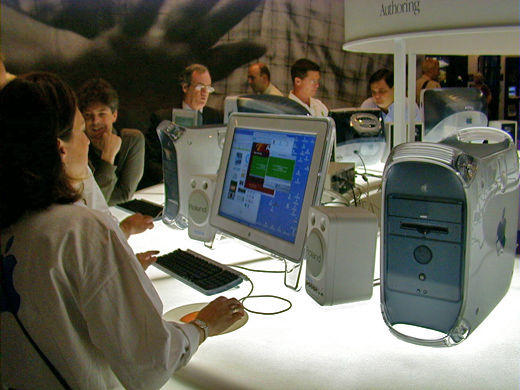
Photo: deltatre
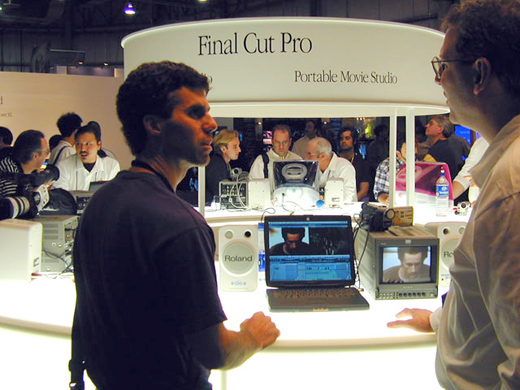
Photo: Jeremy Birn, www.3dRender.com
3DRender.com also has three good quality pictures of Apple’s booth from 2000. From examining them, it’s interesting to note that iMovie and the new iMac DV were featured in the booth as a hardware/software pairing for consumers. The previous year, in 1999, only the Pro-level blue-and-white G3 had DV ports as a standard feature.
2001
I can only find four photos from this year, and none of them are from inside the Convention Center, much less Apple’s booth. QuickTime 5 was released, and Apple announced that many (still) digital camera manufacturers were supporting QuickTime natively — presumably, for saving small movies onto flash memory.
2002
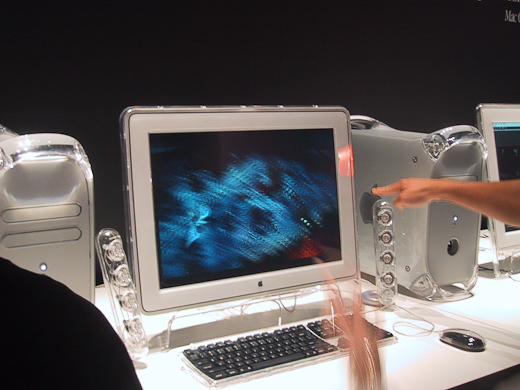
Sorry for the blurry shot, but it’s the one I have that shows the most of the booth. Silver G4s replace the blue-and-white G3s of 1999, and Apple shows off an alpha of their recently-acquired Shake (it would finally ship in July). Here it is being demo’d with some footage from Lord of the Rings on the show floor:
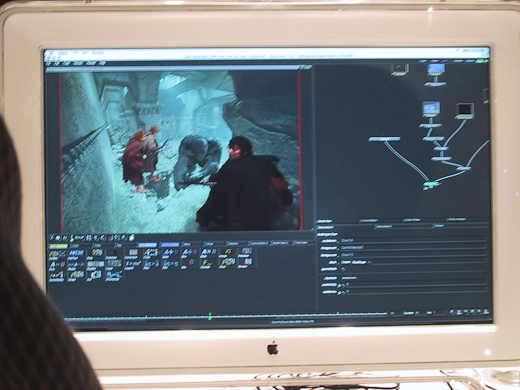
Another shot of Apple’s demonstration area, highlighting the promotion of FCP3’s real-time color correction. Please note the Apple rep pictured here is a really nice guy and is in no way responsible for the movie Scorpion King:
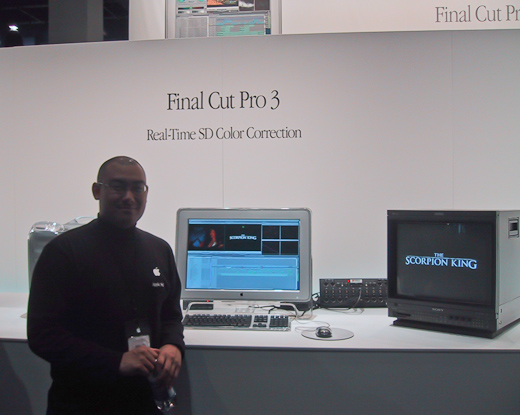
And here’s a dark shot of Apple’s main theater area in their booth:
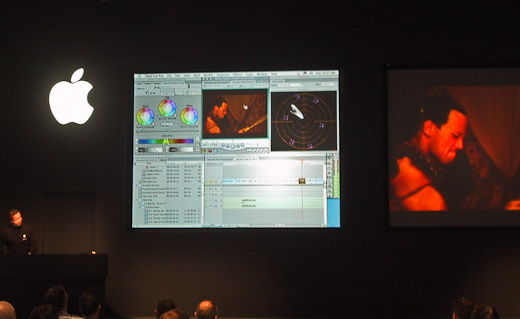
Other products announced at NAB 2002 included DVD Studio Pro 1.5 and Cinema Tools (24fps editing), together with enhanced DVC Pro Support.
2003
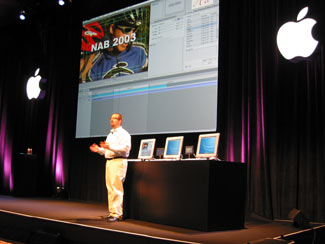
Phil Schiller actually gave the NAB keynote this year, introducing FCP4, DVDSP2, and Shake 3. Schiller shared the stage with Paul Saccone, and Compressor made its debut as well. All seven parts of the keynote are on YouTube, starting with this one:
Judging from the pictures I took, this NAB show stood out most for the appearance of XRaid, Apple’s disk array technology:
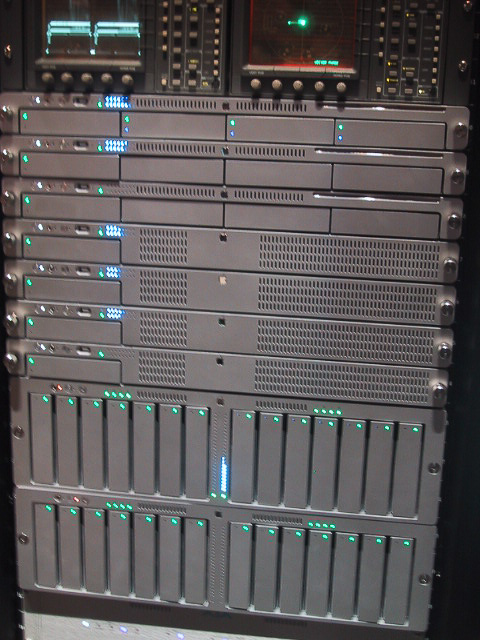
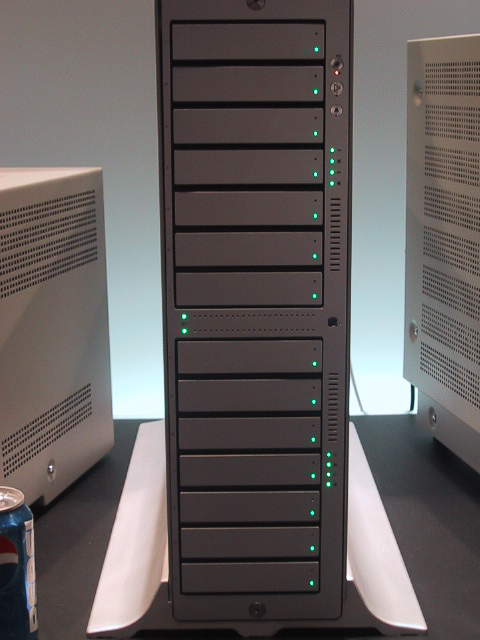
Close-up shot of Compressor being demo’ed at the main theater:
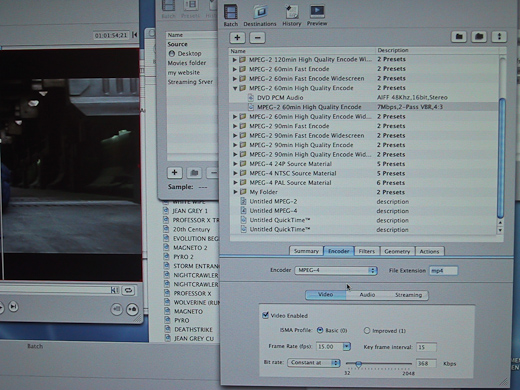
More photos of Apple’s 2003 booth are on ATPM.
2004
Big year for HD:
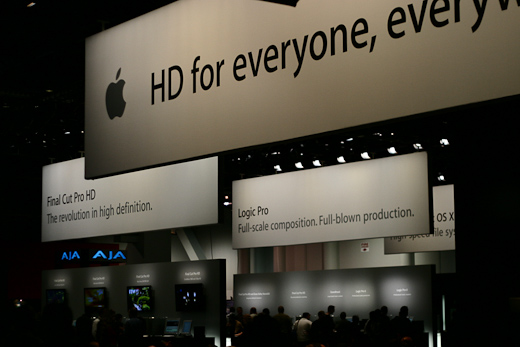
…and G5’s arrive in the XServe:
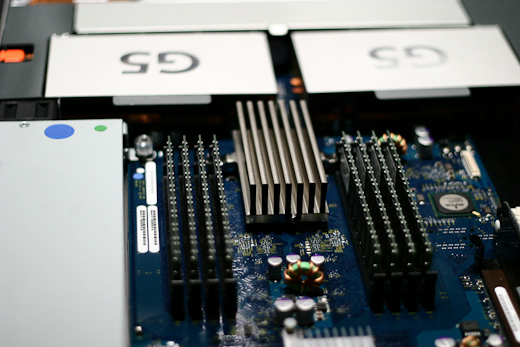
2005
FCP 5 was announced before NAB in, April, and shipped later that May. Tragically I didn’t go to the show, so I can’t show any pictures.
2006
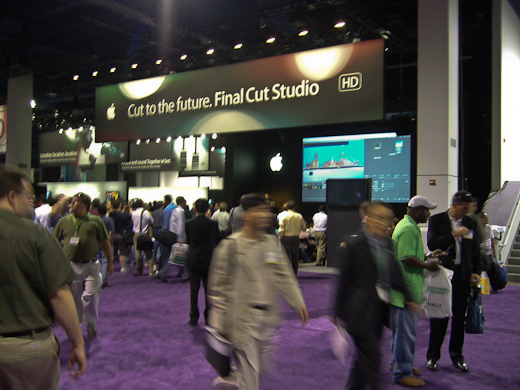
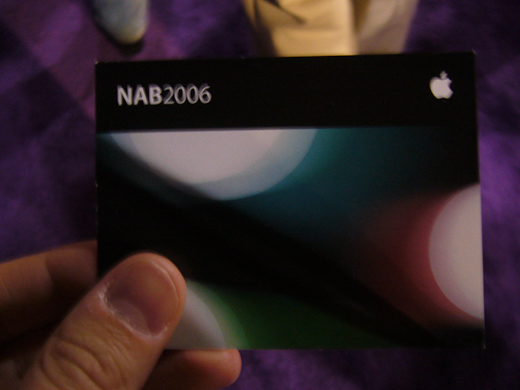
Apple had a really nice classroom set up on the floor, which alternated between training sessions for Final Cut as well as the newly-released Aperture photo editing program:
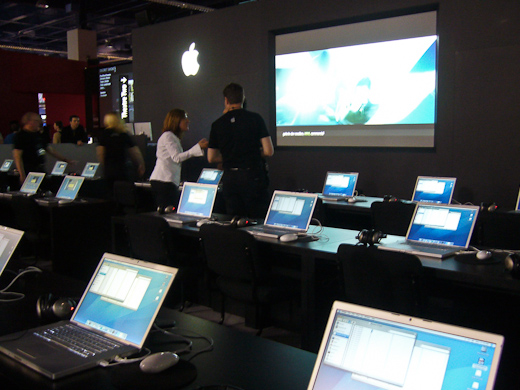
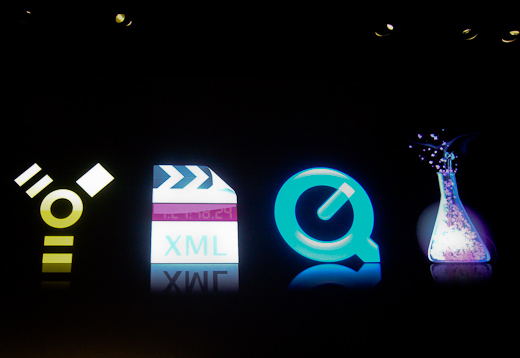 1394 + XML EDL + QT: Slide from Apple’s NAB 2006 Education Aftershow Presentation
1394 + XML EDL + QT: Slide from Apple’s NAB 2006 Education Aftershow Presentation
A rare (blurry) shot behind the scenes of the display area:
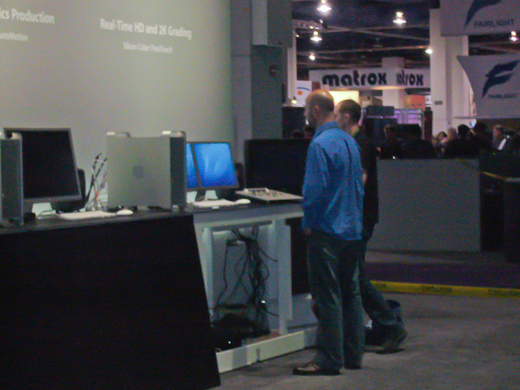
2007
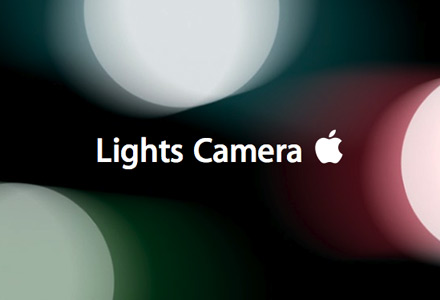
I was in Copenhagen. It was a busy show for Apple: they introduced Final Cut Server and Final Cut Studio 2 (containing FCP 6), together with a new addition Color. Underlying it all was a new editing codec, ProRes 422. You can review Engadget’s live coverage, and here’s Apple’s Demo Reel:
MacBidouille has a great gallery of the keynote, and AppleInsider covers the show floor in pictures.
2008
I was in Sweden, and Apple didn’t have a booth. This was the first time they had skipped a large presence on the show floor, which would continue through 2011.
2009
Again “Apple did not have a booth at NAB 2009,” claims Wikipedia, “however the product was well represented on the show floor in various booths. The RED Camera team relied heavily on FCP during development.” My pictures from the show are here.
2010
Rumors that Apple would return to the show floor with an updated version of Final Cut proved unfounded, and I wasn’t there to snap pictures of the companies that did exhibit.
2011
All I know is, I’ve got my ticket to the Final Cut Pro Supermeet.
